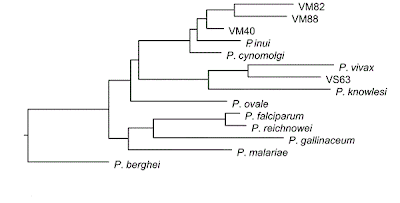Plasmodium
What am I?
I am a parasite that causes malaria. I am transmitted through mosquitoes. I infect red blood cells.
Description
I am a protist that invades the human body and multiplies. I exist as a cause of malaria for humans in five different species: P. falciparum, P. ovale, P. malariae, P. knowlesi, P. vivax. These species differ in some ways, but they all have the same complex life cycle.

I appear in three different forms: merozoite, ookinete and sporozoite. I change forms at different stages of my life. Merozoites are oval shaped and have a single nucleus, a mitochondrion and some ribosomes. They also have rhoptries (in red). Ookinetes are zygotes that are elongated. They also have a nucleus but lack rhoptries. Sporozoites are much longer than merozoites but have similar structures.
I have a nucleus and I lack cilia and flagella so to move, I glide. I am able to enter host cells and live in the cytoplasm of this cell.

I appear in three different forms: merozoite, ookinete and sporozoite. I change forms at different stages of my life. Merozoites are oval shaped and have a single nucleus, a mitochondrion and some ribosomes. They also have rhoptries (in red). Ookinetes are zygotes that are elongated. They also have a nucleus but lack rhoptries. Sporozoites are much longer than merozoites but have similar structures.
I have a nucleus and I lack cilia and flagella so to move, I glide. I am able to enter host cells and live in the cytoplasm of this cell.
Life Cycle
This is the life cycle of Plasmodium falciparum, the species that is most responsible for malaria in the world. It is a complex life cycle that alternates between asexual and sexual reproduction. It also alternate between human and mosquito hosts.
When I am transmitted from the mosquito to a human, I am in the sporozoite form. A female infected mosquito will inject the sporozoites with her saliva when she has a blood meal. I am transferred directly into the circulatory system which delivers me straight to my target: the liver. Here, I enter a host cell in the liver and my nucleus divides many times, producing new Plasmodium cells in the form of merozoites. The liver cells burst and the merozoites enter the bloodstream. Once in the bloodstream, merozoites infect red blood cells where they reproduce asexually and burst out of the cell. The new merozoites infects other red blood cells. This cycle repeats itself over and over again. Every time the release of new merozoites happens, bouts of fever occur, which is what malaria is. Some of the merozoites will develop into gametocytes, which do not harm the host. However, the mosquito takes the gametocytes during a blood meal and they develop into gametes. A male and female gamete come together to form the zygote, which matures into the ookinete. Sexual reproduction occurs in the mosquito. The ookinete moves to the wall of the mosquito's gut, and develops into an oocyst. The oocyst ruptures and releases sporozoites, which migrates to the salivary glands. Through the mosquito's saliva, the sporozoites infect the next human and the cycle continues.
 |
| Click to enlarge |
Evolution
It is estimated that I have some hundreds of species existing in the world today. Early on in my history, it appears that I diverged into two groups - species that infect mammals and species that infest bird or reptile hosts. One of the species that infect humans, P. vivax, is suggested to have arisen by the transfer from monkeys to humans in Asia. It then spread to Africa and then to the Americas by human migration. P. falciparum is believed to have split form another species 6-8 million years ago when humans and chimpanzees also diverged.
Malaria
The main symptom for malaria is a regular occurring fever. Other symptoms include headaches, vomiting, shivers, sweating and exhaustion. If it's not treated properly, malaria can become life-threatening because it will disrupt the blood supply to vital organs such as the brain or kidneys. Symptoms usually develop 10 days to four weeks after being infected by a mosquito. In parts of the world where malaria is common, the parasites have developed resistance to many medicines for malaria.

Malaria is most common in Africa, the Middle East, Asia and central America. This becomes a threat for travellers because they can bring it home with them.

Malaria is most common in Africa, the Middle East, Asia and central America. This becomes a threat for travellers because they can bring it home with them.
Bibliography
Bannister, Lawrence H; and Sherman, Irwin W. (December 2009). Plasmodium. In: Encyclopedia of Life Sciences (ELS). Retrieved November 8, 2011, from <http://www.roitt.com/elspdf/Plasmodium.pdf>
Perez-Jorge, Emilio V. (October 2011). Malaria. Cunha, Burke A. Retrieved November 8, 2011, from <http://emedicine.medscape.com/article/221134-overview>
Macnair, Trisha. (2011). Malaria. Retrieved November 8, 2011, from <http://www.bbc.co.uk/health/physical_health/conditions/malaria1.shtml>
Sumanas, Inc. Malaria: Cooperation among Parasite, Vector, and Host. Retrieved November 8, 2011, from <http://www.sumanasinc.com/scienceinfocus/sif_malaria.html>
Perez-Jorge, Emilio V. (October 2011). Malaria. Cunha, Burke A. Retrieved November 8, 2011, from <http://emedicine.medscape.com/article/221134-overview>
Macnair, Trisha. (2011). Malaria. Retrieved November 8, 2011, from <http://www.bbc.co.uk/health/physical_health/conditions/malaria1.shtml>
Sumanas, Inc. Malaria: Cooperation among Parasite, Vector, and Host. Retrieved November 8, 2011, from <http://www.sumanasinc.com/scienceinfocus/sif_malaria.html>
Subscribe to:
Comments (Atom)
